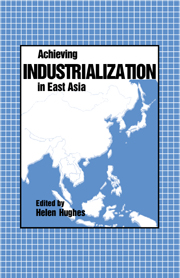Book contents
- Frontmatter
- Contents
- List of figures
- List of tables
- Contributors to this volume
- Preface
- Abbreviations
- Symbols
- 1 Economic Development in East Asia: Doing What Comes Naturally?
- 2 Industrialization and Growth: Alternative Views of East Asia
- 3 The Role of Trade Policies in the Industrialization of Rapidly Growing Asian Developing Countries
- 4 The Role of Foreign Capital in East Asian Industrialization, Growth and Development
- 5 The Role of Government in Overcoming Market Failure: Taiwan, Republic of Korea and Japan
- 6 Growth, Industrialization and Economic Structure: Latin America and East Asia Compared
- 7 Ideology and Industrialization in India and East Asia
- 8 Japan: Model for East Asian Industrialization?
- 9 The Politics of Industrialization in the Republic of Korea and Taiwan
- 10 Economic Growth in the Asean Region: the Political Underpinnings
- 11 Culture and Industrialization
- Bibliography
- Index
7 - Ideology and Industrialization in India and East Asia
Published online by Cambridge University Press: 06 October 2009
- Frontmatter
- Contents
- List of figures
- List of tables
- Contributors to this volume
- Preface
- Abbreviations
- Symbols
- 1 Economic Development in East Asia: Doing What Comes Naturally?
- 2 Industrialization and Growth: Alternative Views of East Asia
- 3 The Role of Trade Policies in the Industrialization of Rapidly Growing Asian Developing Countries
- 4 The Role of Foreign Capital in East Asian Industrialization, Growth and Development
- 5 The Role of Government in Overcoming Market Failure: Taiwan, Republic of Korea and Japan
- 6 Growth, Industrialization and Economic Structure: Latin America and East Asia Compared
- 7 Ideology and Industrialization in India and East Asia
- 8 Japan: Model for East Asian Industrialization?
- 9 The Politics of Industrialization in the Republic of Korea and Taiwan
- 10 Economic Growth in the Asean Region: the Political Underpinnings
- 11 Culture and Industrialization
- Bibliography
- Index
Summary
In 1950 if someone had been asked to predict the Third World country most likely to embark on an industrial revolution and withthe best prospects of fostering modern economic growth – in Kuznets' sense – the unanimous choice would probably have been India. It had a potentially large domestic market, a relatively diversified natural resource base, a relatively efficient bureaucracy, a political leadership seemingly committed to development, fairly elastic supplies of skilled and semi-skilled labour, and no shortage of domestic entrepreneurship. Yet, despite these favourable factors, apart from creating a highly diversified industrial base, both the absolute level of industrialization as well as its contribution to per capita growth has been disappointing, and dismal compared with the experience of the so-called ‘Gang of Four’ of East Asian countries (Singapore, Hong Kong, Taiwan and the Republic of Korea). Table 7.1 provides some summary statistics which give a comparative and historical perspective. India's relative failure to industrialize compared with the comparative ease with which the four East Asian economies have succeeded in transforming their formerly agricultural economies into fully modern industrial ones, is the focus of this paper.
When I write of India I shall be referring not to the political entity which covered the whole sub-continent until 1947, but only the successor state of that name which resulted from the partition which accompanied independence from British rule. I shall be treating the historical experience of Indian industrialization in depth, with only passing references to that of the East Asian economies. This in part reflects my own expertise and partly my desire to tell an analytical story about the sources of the Indian failure.
- Type
- Chapter
- Information
- Achieving Industrialization in East Asia , pp. 195 - 240Publisher: Cambridge University PressPrint publication year: 1988
- 2
- Cited by

